

![]()
Original Fare
Systems |
CER and CRT
Fare Systems
Old CTA
Fare Systems |
Current
Fare System
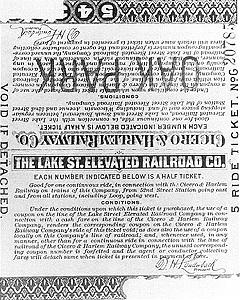 The
Chicago standard in the 19th and early 20th century (for both the "L"
and streetcars) was a nickel flat rate for travel within the city.
All stations had station houses with a ticket agent (an excellent
photo of this can be seen at Lawrence
in 1923), from whom the passenger bought his ticket for 5¢. On
the South Side Rapid Transit, the passenger then deposited their
ticket in a box monitored by a gate keeper who controlled access to
the platform. (The S.S.R.T. also minted tokens which bore the name of
the station at which they were purchased, but it is unclear for how
long, if ever, these were used.) The three other "L" lines has
similar procedures.
The
Chicago standard in the 19th and early 20th century (for both the "L"
and streetcars) was a nickel flat rate for travel within the city.
All stations had station houses with a ticket agent (an excellent
photo of this can be seen at Lawrence
in 1923), from whom the passenger bought his ticket for 5¢. On
the South Side Rapid Transit, the passenger then deposited their
ticket in a box monitored by a gate keeper who controlled access to
the platform. (The S.S.R.T. also minted tokens which bore the name of
the station at which they were purchased, but it is unclear for how
long, if ever, these were used.) The three other "L" lines has
similar procedures.
There was, of course, a catch. The nickel fare only applied for travel within the city. While this was fine for the S.S.R.T., the Northwestern, Metropolitan and Lake Street "L"'s all went outside the city limits and required an additional fare for intercity travel. Sometimes people were caught off-guard by this and even angered, as happened when the Lake Street extended into Oak Park in April 1899 and it was discovered that the coveted nickel fare only applied to travel between Austin and 52nd Avenue; persons traveling in or out of Chicago had to pay an additional nickel. In order to take advantage of the advertised nickel fare in and out of Chicago, a special transfer or the "L"'s special 20-ride ticket (costing $1.00) had to be purchased. Confrontations ensued and soon owner C.T. Yerkes introduced a 5-ride ticket to alleviate some of the problems.
 The
Northwestern has similar requirements. A ride wholly within Evanston
or Chicago cost a nickel (as required by their franchise, not an
usual clause). Passengers crossing the city limits were charged an
additional nickel or could have purchased a ten-cent through-ride
ticket.
The
Northwestern has similar requirements. A ride wholly within Evanston
or Chicago cost a nickel (as required by their franchise, not an
usual clause). Passengers crossing the city limits were charged an
additional nickel or could have purchased a ten-cent through-ride
ticket.
In 1911, under utilities magnate Samuel Insull, the Chicago Elevated Railways Collateral Trust (CER) brought together all four "L" companies, although separate company identities were still maintained. A number of important changes to the fare structure came at this point. Previous to this time, when a passenger changed from one company's car to another's on the Loop, a second nickel fare was required. After 1913, the CER instituted through-routing (between the North and South Sides) and instituted "Universal Transfers", free transfer between lines for trips within the city. Gates separating the different companies' sections of the Loop platforms were removed and the Lake Street Transfer station was erected to facilitate transfers where the Met and Chicago & Oak Park Elevateds crossed at Lake and Paulina. (The transfer station was not yet complete until a few weeks after Universal Transfers took effect, so until completion, blue "walking" transfers were issued for use between the Met's Lake Street station and the C&OP's Wood Street station.) Intracity fares remained fixed a five cents, a boon for riders who'd previously paid ten cents if transferring.
 Unfortunately,
the nickel fare was written into the CER's franchise and by the end
of 1917, CER president Britton I. Budd announced that it no longer
covered operating costs and filed with the Illinois Public Works
Commission to raise the base fare from 5¢ to 7¢. A
"temporary" one-cent increase was awarded November 22, 1918. The CER
argued that this was inadequate. The commission awarded another
"temporary" increase on August 7, 1919, now making the fare 8¢.
Riding within Evanston-Wilmette was raised from 5¢ to 6¢,
while through-rides to the city were now 14¢. February 1, 1920
brought the two for 15 cents discount ticket and inter-zone tickets
costing 12 cents. In July, 1920, the commission granted yet another
increase, now setting the base fare at 10¢ or four tickets for
35¢. Local riding within Evanston-Wilmette was 7¢ while
through-riders could pay 17¢ cash or buy 13¢ tickets. In
its last act before being the replaced by the Illinois Commerce
Commission in 1921, the Illinois Public Utilities Commission made
this fare structure permanent.
Unfortunately,
the nickel fare was written into the CER's franchise and by the end
of 1917, CER president Britton I. Budd announced that it no longer
covered operating costs and filed with the Illinois Public Works
Commission to raise the base fare from 5¢ to 7¢. A
"temporary" one-cent increase was awarded November 22, 1918. The CER
argued that this was inadequate. The commission awarded another
"temporary" increase on August 7, 1919, now making the fare 8¢.
Riding within Evanston-Wilmette was raised from 5¢ to 6¢,
while through-rides to the city were now 14¢. February 1, 1920
brought the two for 15 cents discount ticket and inter-zone tickets
costing 12 cents. In July, 1920, the commission granted yet another
increase, now setting the base fare at 10¢ or four tickets for
35¢. Local riding within Evanston-Wilmette was 7¢ while
through-riders could pay 17¢ cash or buy 13¢ tickets. In
its last act before being the replaced by the Illinois Commerce
Commission in 1921, the Illinois Public Utilities Commission made
this fare structure permanent.
Fares were again changed August 18, 1922. Riders were encouraged to buy rides in advance. A three-ride ticket sold for 25¢, while four rides cost 35¢, saving a nickel. Also, the Weekly Pass, a tradition that carries on today, was first introduced here, costing $1.25 within the city and $2.00 for travel between Chicago and Evanston-Wilmette. (The same rules apparently applied to travel beyond Des Plaines on the Garfield Park Branch of the Metropolitan "L".) There were also reduced fares of 3¢ for children under 12, 5¢ for students under 17 and 25¢ round-trip for travel between Chicago and station on the Evanston, Niles Center and Westchester branches.
In 1924, Samuel Insull realized that for the sake of the "L"'s continued longevity, it would have to be completely consolidated, with all the companies officially merging into one. The Chicago Rapid Transit Company (CRT) accomplished this and under the CRT, both the "L"'s service and fares continued to grow. In February, 1928, the CRT filed with the Illinois Commerce Commission to abolish the three-ride ticket and the intracity Weekly Pass. The CRT insisted this was necessary to finance new cars and maintenance and to insure a reasonable return. Hearings dragged on as the City of Chicago strongly opposed the CRT. The commission denied the request in June, but the U.S. District Court issued a temporary injunction and the new fare structure went into effect July 18. The pass abolition was temporary, however, as the CRT introduced a 90¢ Weekly Pass good for travel within a three-mile radius of the Loop on April 11, 1932 to boost low Depression ridership. A $1.35 pass was issued for travel east of Des Plaines and south of Howard. But the downward spiral continued and receivership came to the CRT June 6, 1932.
By 1943, it became apparent that privately owned public transit in Chicago could not survive due to its unprofitability. The time was right for municipal ownership and in 1945, a public transit authority was authorized for Chicago, though it was not until 1947 that the transfer of assets was complete. The Chicago Transit Authority (CTA) took over "L" service and was vested with the power to set its own fares. However, it was also saddled with the requirement to earn at least half its operating funds from the farebox, a somewhat paradoxical clause since the fact that public transit was no longer self-sustaining was what drove it to public ownership in the first place. Since fares were now a major part of how the CTA would sustain itself, riders experienced a series of regular fare increases through the years.
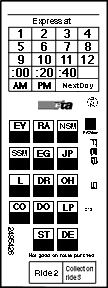 When
the CTA took over, it raised "L" fares from 10¢ to 12¢. By
1952, the CTA fare was up to 20¢. In 1957, the base fare was
raised to 25¢, where the rates stayed for ten years. In 1961, a
new charge of 5¢ was added for a transfer. On August 18, 1965,
the Illinois State Legislature authorized the first reimbursement to
the CTA for its long-standing program of providing reduced fares for
elementary and high school students. On April 20, 1969, the first
reduced fare for senior citizens took effect for those riding between
9 am and 3 pm Monday through Saturday and from 7 am to midnight
Sundays and holidays. This service was extended to all hours November
5, 1972. The closing years of the 1960s saw CTA fares go up to
30¢ (1967), 40¢ (1969) and by 1970 the fare was up to
45¢, with 10¢ for a transfer.
When
the CTA took over, it raised "L" fares from 10¢ to 12¢. By
1952, the CTA fare was up to 20¢. In 1957, the base fare was
raised to 25¢, where the rates stayed for ten years. In 1961, a
new charge of 5¢ was added for a transfer. On August 18, 1965,
the Illinois State Legislature authorized the first reimbursement to
the CTA for its long-standing program of providing reduced fares for
elementary and high school students. On April 20, 1969, the first
reduced fare for senior citizens took effect for those riding between
9 am and 3 pm Monday through Saturday and from 7 am to midnight
Sundays and holidays. This service was extended to all hours November
5, 1972. The closing years of the 1960s saw CTA fares go up to
30¢ (1967), 40¢ (1969) and by 1970 the fare was up to
45¢, with 10¢ for a transfer.
The new approach of municipal ownership worked for a generation, but as quickly rising fares proved, it began to fail around 1970 as system-generated revenues no longer could be stretched to cover operating costs, equipment renewal and investments. The creation of the Regional Transportation Authority (RTA) in 1973 helped keep fares relatively stable through that decade. Public transit would now be subsidized. On March 10, 1974 the CTA began to offer bargain fares on Sundays and on June 2 began the experimental use of a Sunday "Super Transferpass," permitting unlimited riding for a single fare. On November 26, 1979, the Monthly Pass went on sale.
In 1980, the state subsidy to the RTA was dropped, resulting in a funding crisis at the RTA. Transit fares skyrocketed, with the CTA fare rising to 60¢ in 1980, 80¢ in January 1981 and 90¢ only six months later! During the same period, Monthly Pass prices rose quickly from $30.00 (in 1980) to $35.00 (January 1981) and then $40.00 (June 1981). By 1982, the surcharge for Evanston Express riders (all stops in Evanston, then express service to the Loop during rush hours) was 20¢. The state subsidy was restored in 1983. Transfers had stayed at 10¢ until January 1986 when they rose to 25¢ as rail fares finally hit $1.00 and the Monthly Pass now cost a lofty $46.00. On March 27 of that year, the CTA 14-Day Pass went on sale. August 3, a test program was instituted at the Morse station requiring exact fares for rapid transit riders. It was a failure.

 In
1950, the CTA started selling tokens for use on the surface system.
Tokens eventually became accepted on both buses and rapid transit
trains, and by the time of their retirement in 1999 cost $15.00 for
ten, equal to ten times the single cash fare. For years, ten tokens
had cost $13.50, offering a discount. But, with the introduction of
the stored value Transit Card, the CTA offered this discount instead
on Transit Cards to encourage riders to switch. Reduced fare tokens
were also available. Full fare tokens are silver and about 5/8 inches
in diameter. Reduced fare token (pictured above) are the exact same
design, except they're stamped in copper and are larger, about 3/4
inches in diameter. On June 1, 1999, the CTA retired tokens for good,
accepting only Transit Cards and cash fares (on buses).
In
1950, the CTA started selling tokens for use on the surface system.
Tokens eventually became accepted on both buses and rapid transit
trains, and by the time of their retirement in 1999 cost $15.00 for
ten, equal to ten times the single cash fare. For years, ten tokens
had cost $13.50, offering a discount. But, with the introduction of
the stored value Transit Card, the CTA offered this discount instead
on Transit Cards to encourage riders to switch. Reduced fare tokens
were also available. Full fare tokens are silver and about 5/8 inches
in diameter. Reduced fare token (pictured above) are the exact same
design, except they're stamped in copper and are larger, about 3/4
inches in diameter. On June 1, 1999, the CTA retired tokens for good,
accepting only Transit Cards and cash fares (on buses).
CTA rapid transit stations traditionally had agents in booths to collect fares tokens or transfers, and allow passengers through the turnstiles. Many stations had "automatic" turnstiles which took exact change or tokens, and some of them issued transfers. For many years, many rapid transit stations had been left unattended during slack periods, with fare collection by conductors on the trains.
Again, state and federal transit subsidies usually have not been adequate enough, and there have been fare increases throughout the 1990's. The current CTA cash fare is $1.50, with 30¢ for a transfer.
Today, there are several ways to pay CTA fares: with cash, Monthly Pass, Transit Card, Visitor Pass, or the Chicago CardTM or Chicago Card PlusTM smart cards. All adults (12 years of age or older) are full fare ($1.75). Children (7 through 11 years of age), the elderly (65 years of age and older, RTA Reduced Fare Permit required), riders with disabilities, regardless of age (RTA Reduced Fare Permit required) and elementary and high school students presenting a valid CTA Student Riding Permit between 0530 and 2000 hours only on weekdays when school is in session, for school purposes pay a reduced fare (85¢). Children 6 years of age and younger accompanied by a fare-paying rider and uniformed or ID-bearing city workers such as transit employees and police and fire department personnel ride for free.
Now that fare collection at rapid transit stations has become automated, the need for agents to collect fares has been eliminated. Transit Cards are sold by vending machines, and one turnstile at each station is equipped for exact change or tokens. Change machines are also available at stations. The agents are now "Customer Assistants", who no longer are necessarily confined to the agents booths.
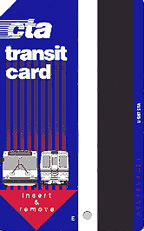 Transit
Cards
Transit
Cards
Buses and turnstiles deduct full fares and transfer charges from Transit Cards as shown.
Pre-valued Transit Cards are sold at currency exchanges, Jewel and Dominick's stores, and many other locations.
 Transit
Cards can be purchased and value can be added to Transit Cards at
vending machines located at all CTA rail stations. Vending machines
accept one, two, five, ten, and twenty dollar bills, and most coins.
Any value can be added to an existing Transit Card as long as total
value does not exceed $100.00. Up to 7 full fare individuals can use
one Transit Card with transfer eligibility maintained for each
individual. Each inserts the card separately into the turnstile or
farebox.
Transit
Cards can be purchased and value can be added to Transit Cards at
vending machines located at all CTA rail stations. Vending machines
accept one, two, five, ten, and twenty dollar bills, and most coins.
Any value can be added to an existing Transit Card as long as total
value does not exceed $100.00. Up to 7 full fare individuals can use
one Transit Card with transfer eligibility maintained for each
individual. Each inserts the card separately into the turnstile or
farebox.
Additionally, the following pre-valued Transit Cards are sold at sporting and special events: full Fare Transit Card with $1.75 of value for $1.75, good for one base fare; and full Fare Transit Card with $2.00 of value for $2.00, good for one base fare and transfer.
Click here to see the CTA's Transit Card regulations.
Transfer Cards
A transfer allows two additional rides within two hours of issue. Connections between rail routes are free. A full transfer fare is 25¢, reduced is 15¢. Transfer Cards, Transit Cards, and Reduced Fare Permits all have the ability to keep track of the additional rides. Passengers using cash and token can purchase a Transfer Card only when paying their base fare. A Transfer Card is issued only at the time a base and transfer fare is paid using cash or token. The expiration time, date, vehicle or station number, and type of Transfer Card is printed on the back of the Transfer Card.
Click here to see the CTA's Transfer Card regulations.
Visitor Passes
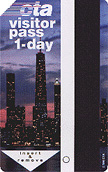 |
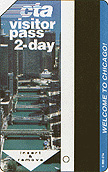 |
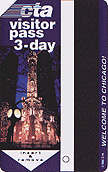 |
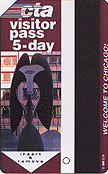 |
|
|
|
|
|
Now, the CTA also offers a Visitor Pass, perfect for tourists and visitors to the Windy City. For only $5.00 for one person's use, the CTA Visitor Pass is valid for 24 hours from the first use for unlimited riding on the CTA. The passes are available at O'Hare and Midway Airports, select Chicago area hotels, tourist locations (such as city museums) and select retail outlets. The card is used the same as a Transit Card, and simply becomes void after the period expires. The cards cannot be recharged.
The CTA also offers a variety of other Visitor Passes to suit the needs to every traveler. 2-day, 3-day, 5-day, and 7-day passes are available, also with unlimited rides on all CTA services.
The CTA also has a special group program for groups of 15 or more. The Visitor Passes can be ordered in advance and they will also show you how to use the system to get where you want to go. They will send you free maps and brochures and provide customized group itineraries. To order in advance, just send a cover letter along with a company check or money order to:
Visitor Pass Program
Chicago Transit Authority
120 North Racine Avenue
Chicago, IL 60607
Allow 2 weeks for processing.
Passes
The CTA also issues a number of passes, good for a certain time increment. These are accepted for unlimited riding on CTA and most Pace routes, by one person only. The CTA Full Fare Monthly Pass is $75.00 for unlimited rides (decreased from $88.00 circa 2000). The CTA Senior Monthly Pass is $44.00 for unlimited rides, but Senior passes can be used only by senior citizens with a valid RTA Reduced Fare Permit. Senior Pass users will first insert and remove their pass, then insert and remove their Permit. The CTA Accommodation Monthly Pass is $35.00 for unlimited rides, though the Accommodation pass can only be used by people with disabilities who have a valid RTA Reduced Fare Permit with a serial number beginning with the letter "D" or "P". An RTA Reduced Fare Permit is acquired from RTA (836-7000). Student Reduced Fare Permits are valid between 0530 and 2000 hours only on weekdays when school is in session. A Regular School Year Permit is $5.00; a Summer Session Permit is $2.00. Buses and turnstiles deduct reduced fares and transfer charges from Reduced Fare Permits as shown.
Value can be added to Reduced Fare Permits at vending machines located at CTA rail stations, with the same rules as apply for Transit Cards applying here. A Reduced Fare Permit with an ID number beginning with the letter "P" allows one reduced fare for the Permit holder and one reduced fare for an attendant accompanying the Permit holder to be paid using the Permit with transfer eligibility maintained for both individuals.
Tax-Exempt Transit
Recently, the CTA began offering businesses a program that lets their employees buy transit checks or CTA passes with their pre-tax dollars. Employers have an advantage with the program because the more employees deduct from their paycheck, the less employers end up paying for payroll taxes. The tax-exempt transit program also ends up being a substantial discount for the employee, who may save several dollars each month on a monthly pass, which can add up to savings well over $100 every year.
Most of the historical data came from the books CTA at 45;
The "L": The Development of Chicago's Rapid Transit System,
1888-1932 and the CTA 1987 Historical Calendar. More
current information came from various maps and pamphlets issued by
the CTA and RTA, as well as the CTA
Official Web Site. Thanks
to all these sources for a plethora of information.